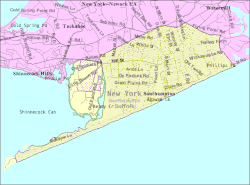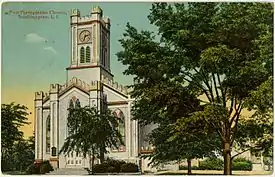Southampton (village), New York
Southampton is a village in Suffolk County, New York, United States. The village is named after the Earl of Southampton. The Village of Southampton is in the southeast part of the county in the Town of Southampton.[3] The population was 3,109 at the 2010 census.[4]
Southampton, New York | |
|---|---|
Village | |
| Village of Southampton | |
 | |
 Southampton Official Census map of village limits | |
| Coordinates: 40°53′7″N 72°23′43″W | |
| Country | United States |
| State | New York |
| County | Suffolk |
| Government | |
| • Mayor | Jesse Warren |
| Area | |
| • Total | 7.55 sq mi (19.55 km2) |
| • Land | 6.75 sq mi (17.47 km2) |
| • Water | 0.80 sq mi (2.08 km2) |
| Elevation | 26 ft (8 m) |
| Population (2010) | |
| • Total | 3,109 |
| • Estimate (2019)[2] | 3,307 |
| • Density | 490.29/sq mi (189.31/km2) |
| Time zone | UTC-5 (Eastern (EST)) |
| • Summer (DST) | UTC-4 (EDT) |
| ZIP codes | 11968-11969 |
| Area code(s) | 631 |
| FIPS code | 36-68462 |
| GNIS feature ID | 0965893 |
| Website | www |
Southampton is the oldest and largest of communities in the summer colony known as The Hamptons. It is also arguably the commercial center of the southern "fork" of Long Island, serves as the home base for several region-wide businesses and has the area's only hospital. Southampton Village is generally considered one of the area's two most prestigious communities.
Many wealthy and influential people have homes in the "estate section" of the village, the area immediately north of the Atlantic Ocean front. Southampton has historically been home to prominent residents including members of the Ford, Du Pont, Eisenhower, Vanderbilt and Morgan families.[5] Today, the village is itself home to approximately half of the billionaires who have residences in the eight hamlets and villages that constitute the Hamptons.[6]
Southampton Village has a relatively large year round population, at approximately 3,100 residents. It has 2 - 3x the population of any of the other villages or hamlets in the Hamptons. As a result, it is the most densely populated and most built up of the communities in the Hamptons. It is also the most diverse of the villages and hamlets that constitute the Hamptons. Southampton Village has the largest communities of African Americans, Hispanics and Asians (in percentage terms and in absolute numbers) in the Hamptons.[7]
The incorporated Village of Southampton is headed by Mayor Jesse Warren.[8] At the time of his election, the 37 year old became the village's youngest mayor.[8] This area is policed by the Southampton Village Police Department.
History

Southampton, settled in 1640 and incorporated as a village in 1894, historically began with a small group of English settlers who set sail from Lynn, Massachusetts, and landed on June 12, 1640, at what is now known as Conscience Point. It is the oldest English settlement in the state of New York and is named after the English Earl of Southampton.
The Shinnecock tribe welcomed the arrival of the white settlers in 1640 and not only gave them land to live on, "Olde Towne", but also shared with the settlers their knowledge of planting corn and fertilizing it with fish, growing crops, digging clams and scallops from nearby bays and trapping game. During the 18th and 19th centuries, fishing, farming (especially potatoes and the local sweet corn) and duck raising were the predominant industries.
The early settlers, with the help of a resident Shinnecock Indian guide, were led over an old woodland trail that is now North Sea Road to an ideal spot for their first settlement. There, at the head of what today is Old Town Pond, they constructed their first homes. The Shinnecock Reservation, established in 1701, is one of the oldest Native American reservations in the United States.
A property called the Halsey House was a homestead by pioneer Thomas Halsey in 1640. A rare "first period" house was built in 1660 when Main Street, in the pioneer hamlet of Southampton, was first laid out. Its owner, Thomas Halsey, was one of the original families who bought property from the Shinnecocks in 1640.[10] It is one of the oldest English-type frame houses in the state.
Summer Colony

Dr. Theodore Gaillard Thomas, a New York City physician is regarded at the founder of the resort community, also termed the Summer Colony, of Southampton. He convinced a number of his wealthy clients about the beauty and potential restorative nature of the rural environment of Southampton. His efforts to develop this resort community began in 1863. He proved very successful at establishing what grew into a very prominent and affluent community of summer residents. Dr. Thomas and his friends ultimately established many of the leading institutions in Southampton including the St. Andrews Dune Church, the Shinnecock Golf Club, the Meadow Club, the Southampton Beach Club and The Parrish Art Museum (now located in Water Mill, NY).[11]
Over time, several of the other villages and hamlets in what has become called the Hamptons increasingly became a haven for affluent summer season vacationers. Southampton Village, which hosted the earliest summer community of socially prominent residents and was arguably the center for upper class Americans, grew larger and faster than the others. Southampton has served as home to members of the Ford, Du Pont, Morgan, Atterbury, Woolworth and Eisenhower families.[12]
21st-century
Southampton Village is regarded as one of the premier summer resort areas in the country.[13] The community of summer residents occupy the top echelon of American social, political and financial circles.
Accordingly, real estate is extremely expensive in the village. The Estate Section, which contains the majority of the homes for the very affluent residents, lies directly north of the Atlantic oceanfront and extends to Hill Street. Particular streets of note in the area include Ox Pasture Road, Halsey Neck Lane, Coopers Neck Lane, First Neck Lane and South Main Street. The homes around Lake Agawam, referred to by Dr. Thomas as "the very center of our Summer Colony" are particularly noteworthy for their architectural pedigree and historical provenance.
The oceanfront roads - Gin Lane and Meadow Lane - are generally the most expensive roads in the village. Meadow Lane in particular has been called Billionaire Lane, and cited as having among the most expensive residential real estate in the country.[14]
Other areas in the village house the relatively large population of year-round residents. These neighborhoods extend from Hill Street northwards to Route 27, east to the hamlet of Water Mill, and west to the area of Tuckahoe in Southampton Town.
The Shinnecock Indian Reservation borders the village on its southwestern border. Shinnecock Hills Golf Club one of the oldest and most prestigious golf courses in the country, borders the village on its northwest corner. The Art Village, a summer art school started by William Merritt Chase and funded by early residents of the Southampton Summer Colony, is still in existence, though now it is entirely private residences; no arts education is conducted in the Art Village any more.
There are several working farms and agricultural preserves in the village.[15] Most of those properties are located in the Estate Section, particularly in the Wickapogue Road Historic District.
Southampton Village boasts well regarded ocean beaches including Cooper's Beach, which was voted #3 in a recent national poll. In 2010 it was listed as America's top beach according to the annual list of the best American beaches compiled by Dr. Stephen Leatherman, AKA Dr. Beach.[16]
Geography
Southampton is located at 40°53′6″N 72°23′42″W (40.885188, −72.395162).[17]
According to the United States Census Bureau, the village has a total area of 7.2 square miles (18.7 km2), of which 6.4 square miles (16.6 km2) is land and 0.81 square miles (2.1 km2), or 11.03%, is water.[4]
The village gained territory between the 1990 census and the 2000 census; the Southampton CDP that existed in 1990 was deleted and most of its territory went to two adjacent CDPs.[18]
| Historical population | |||
|---|---|---|---|
| Census | Pop. | %± | |
| 1870 | 943 | — | |
| 1880 | 949 | 0.6% | |
| 1900 | 2,289 | — | |
| 1910 | 2,509 | 9.6% | |
| 1920 | 2,891 | 15.2% | |
| 1930 | 3,737 | 29.3% | |
| 1940 | 3,818 | 2.2% | |
| 1950 | 4,042 | 5.9% | |
| 1960 | 4,582 | 13.4% | |
| 1970 | 4,904 | 7.0% | |
| 1980 | 4,000 | −18.4% | |
| 1990 | 3,980 | −0.5% | |
| 2000 | 3,965 | −0.4% | |
| 2010 | 3,109 | −21.6% | |
| 2019 (est.) | 3,307 | [2] | 6.4% |
| U.S. Decennial Census[19] | |||
Demographics
According to US Census estimates [20] as of March 2017, there were 3,193 people in the village. The population density was 498.9 people per square mile (192.6/km2). The racial makeup of the village was 74.5% White, 16.7% Black or African American, 0.4% Native American, 3.60% Asian, 0.03% Pacific Islander, 4.40% from other races, and 0.90% from two or more races. Hispanic or Latino of any race were 94.30% of the population.
In the village, the population was spread out, with 16.2% under the age of 19, 1.7% from 18 to 24, 12.4% from 19 to 34, 39.8% from 35 to 64, and 29.9% who were 65 years of age or older. The median age was 55.2 years. The Village's residents were estimated to be 46% male and 54% female.
Also, as per the 2015 Census Data estimates, the median income for a household in the village was $96,250 and the median income for a family was $109,674. Twenty two percent of the households in the Village earned over $200,000.
As per the 2000 Census, there were 1,651 households, out of which 21.9% had children under the age of 18 living with them, 42.1% were married couples living together, 12.1% had a female householder with no husband present, and 40.5% were non-families. 34.2% of all households were made up of individuals, and 15.4% had someone living alone who was 65 years of age or older. The average household size was 2.36 and the average family size was 2.97.
Historic districts
Notable current and former residents
Image gallery
References
External links
|





